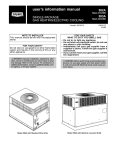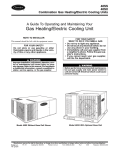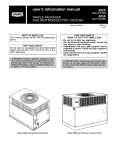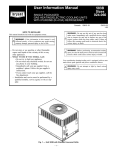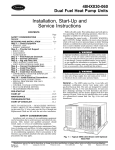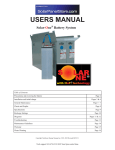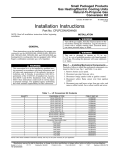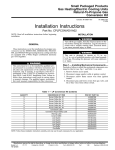Download Carrier 48HX Specifications
Transcript
48HX Dual Fuel Heat Pump Units A Guide To Operating and Maintaining Your Dual Fuel Heat Pump Unit NOTE TO INSTALLER This manual should be left with the equipment owner. FOR YOUR SAFETY Do not store or use gasoline or other flammable vapors and liquids in the vicinity of this or any other appliance. • • • • Improper installation, adjustment, alteration, service or maintenance can cause injury or property damage. Refer to this manual. For assistance or additional information, consult a qualified installer, service agency, or the gas supplier. FOR YOUR SAFETY WHAT TO DO IF YOU SMELL GAS Do not try to light any appliance. Do not touch any electrical switch; do not use any phone in your building. Immediately call your gas supplier from a neighbor’s phone. Follow the gas supplier’s instructions. If you cannot reach your gas supplier, call the fire department. Before performing recommended maintenance, be sure gas supply and main power switch to unit are turned off. Electrical shock could cause personal injury. 48HX Unit Without Base Rail 48HX Unit With Optional Base Rail Manufacturer reserves the right to discontinue, or change at any time, specifications or designs without notice and without incurring obligations. Book 1 4 PC 111 Catalog No. 564-908 Printed in U.S.A. Form 48HX-1SO Pg 1 12-94 Replaces: New Tab 5a 5a for your liking. Continuous fan operation minimizes any temperature differences. Also, systems equipped with electronic air cleaners and/or humidifiers offer the added benefits of having the air continuously cleaned year-round, and humidified during the winter season. • Your dual fuel heat pump will remove humidity from your home during the cooling season. After a few minutes of operation, you should be able to see water trickle from the condensate drain. Check this occasionally to be sure the drain system is not clogged. Of course, don’t expect to see much drainage if you live in a very dry climate. WELCOME TO EFFICIENT YEAR-ROUND COMFORT Congratulations on your excellent choice and sound investment in home comfort! Your new dual fuel heat pump represents both the latest in engineering development and the culmination of many years of experience from one of the most reputable manufacturers of comfort systems. Your new unit is among the most reliable home comfort products available today. To assure its dependability, spend just a few minutes with this booklet now. Learn about the operation of your dual fuel heat pump and the small amount of maintenance it takes to keep it operating at its peak efficiency. With minimal care, your dual fuel heat pump will provide you and your family with satisfying home comfort — both now and for years to come. OPERATING YOUR DUAL FUEL HEAT PUMP The operation of your dual fuel heat pump is controlled by the indoor thermostat. You simply adjust the thermostat and it maintains the indoor temperature at the level you select. Most thermostats for the dual fuel heat pump systems include temperature control selector, FAN switch, and SYSTEM switch. EMERGENCY HEAT (EM HEAT) setting also is provided with the SYSTEM switch. See Fig. 1. The temperature control selector is a dial or lever that allows you to establish the temperature that you wish to maintain for your personal comfort. Some thermostats possess two temperature control selectors: one for setting the temperature desired during the cooling cycle, and one to set the heating operation temperature. Typical settings are 78 degrees Fahrenheit for cooling and 68 degrees for heating. The FAN switch offers two options for controlling the blower: AUTO and ON. When set to AUTO, the blower will run during the time the dual fuel heat pump is operating. When the FAN switch is set at the ON position, the blower will run continuously. Typically, the SYSTEM switch on your thermostat offers the following selections: COOL, OFF, HEAT, and EMERGENCY HEAT. Your thermostat may also have another selection, AUTO. The heat pump will not operate when the SYSTEM switch is set at the OFF position. With the SYSTEM switch set at COOL, your heat pump will operate in its cooling mode when the indoor temperature rises above the level that you wish to maintain. With the SYSTEM switch set at the HEAT position, your dual fuel heat pump will provide warmth whenever the indoor temperature falls below the level that you have selected. The AUTO selection found on some thermostats provides for automatic changeover between cooling and heating cycles. With the SYSTEM switch set in the AUTO position, the cooling mode is activated when the indoor temperature rises above the thermostat cooling temperature setting, or the heating mode will be activated when the indoor temperature drops below the thermostat setting for the heating cycle. Your home comfort system includes supplementary gas heat. Your system will turn on gas heat only as necessary to meet your heating needs during defrost cycles or when outdoor temperatures are low. In the event of a heat pump malfunction, you can use the EMERGENCY HEAT setting on your thermostat to manually select gas heat. Heat pump heating is deactivated when EMERGENCY HEAT is selected. If it becomes necessary to use EMERGENCY HEAT to provide heat, call your dealer for service as soon as is practical. See your thermostat owner’s manual for additional information. IMPORTANT FACTS To better protect your investment and to eliminate unnecessary service calls, familiarize yourself with the following facts: Improper installation, adjustment, alteration, service, maintenance, or use can cause explosion, fire, electrical shock, or other conditions which may cause personal injury or property damage. Refer to this manual. For assistance or additional information consult a qualified installer, service agency, distributor, or branch. The qualified installer or agency must use only factory-authorized kits or accessories when modifying this product. • Your dual fuel heat pump system should never be operated without a clean air filter properly installed. Plan to inspect the filter periodically. A clogged air filter will increase operating costs and shorten the life of the unit. • Supply-air and return-air registers should not be blocked. Drapes, furniture, and toys are some of the items commonly found obstructing grilles. Restricted airflow lessens the unit’s efficiency and life span. • Outdoor units must have unrestricted airflow. Do not cover the unit, lean anything against it, or stand upon it. Do not allow grass clippings, leaves, or other debris to accumulate around or on top of the unit. Maintain a 12-in. minimum clearance between the outdoor unit and tall grass, vines, shrubs, et cetera. • Your multipurpose indoor thermostat is the control center for your dual fuel heat pump system. You should familiarize yourself with its proper operation. Attempting to control the system by other means — for instance, switching the electrical supply power ON and OFF — may cause damage to the unit. • Thermostat ‘‘jiggling’’ causes rapid-cycling, which is potentially damaging to the compressor. Do not move the temperature selector on the thermostat for any reason for at least 5 minutes after the compressor has shut off. • You may find that you can maintain greater personal comfort by running the fan continuously. ‘‘Air pockets’’ can form due to the structure of the building, placement of registers, et cetera. These air pockets may be too cool or warm 2 Cooling Cycle — When operating in the cooling cycle, your dual fuel heat pump will run until the indoor temperature is lowered to the level you have selected. On extremely hot days, your dual fuel heat pump will run for longer periods at a time and have shorter ‘‘off’’ periods than on moderate days. The following are typical conditions that add extra heat and/or humidity to your home. Your heat pump will work longer to keep your home comfortable under these conditions: • Entrance doors are frequently opened and closed • Laundry appliances are being operated • A shower is running • More than the usual number of people are present in the home • More than the normal number of electric lights are in use • Drapes are open on the sunny side of the home Fig. 1 — Typical Thermostat TO LIGHT UNIT Your dual fuel heat pump is equipped with an automatic direct spark ignition and power combustion blower. Heating Cycle — With the SYSTEM switch of your indoor thermostat set to the HEAT position, the dual fuel heat pump will operate in its heating mode until room temperature is raised to the level you have selected. Of course, the heating unit will have to operate for longer periods to maintain a comfortable environment on colder days and nights than on moderate ones. DEFROST CYCLE — When your dual fuel heat pump is providing heat to your home and the outdoor temperature drops below 45 degrees Fahrenheit, moisture may begin to freeze on the surface of the outdoor coil. If allowed to build up, this ice would impede airflow across the coil and reduce the amount of heat absorbed from the outside air. So, to maintain energy-efficient operation, your dual fuel heat pump has an automatic defrost cycle. Depending on which model you have, the defrost cycle starts at a preset time interval of 30, 50, or 90 minutes. However, it may be reset. Defrost will start at the preset time only if the ice is sufficient to interfere with normal heating operation. After the ice is melted from the outdoor coil, or after a maximum of 10 minutes in the Defrost mode, the unit will automatically switch back to normal heating operation. Do not be alarmed if steam or fog appears at the outdoor unit during the defrost cycle. Water vapor from the melting ice may condense into a mist in the cold outside air. EMERGENCY HEAT — The EMERGENCY HEAT setting on your thermostat refers to supplementary gas heating that is included in your home comfort system. Operation of the EMERGENCY HEAT source may be required if the heat pump malfunctions. The red light on your thermostat will glow if the SYSTEM switch is moved from HEAT to the EMERGENCY HEAT setting. This indicates that the heat pump is off and the supplemental gas heating is selected for operation. Also, your particular model of heat pump may include a Service Sentry™ circuit, which is used with a thermostat that includes a red warning light. The red warning light will glow if the compressor malfunctions. Call your dealer for immediate service if you suspect trouble. Do not attempt to light by hand; personal injury may result. 1. Do not turn off the electrical power to unit without first turning off the gas supply. 2. Before attempting to start the gas heating section, familiarize yourself with all the procedures that must be followed. If you do not follow these instructions exactly, a fire or explosion may result, causing property damage, injury, or loss of life. Refer to Fig. 2. See Fig. 3 for location of gas valve. Refer to Fig. 4 while proceeding with the following steps. Step 1 — Set the temperature selector on room thermostat to the lowest temperature setting and set SYSTEM switch to EM HEAT. Step 2 — Close the external manual shutoff valve. Step 3 — Turn off the electrical supply to the unit. Step 4 — Remove the burner access panel with a 5⁄16-in. nut driver. Step 5 — Turn the control dial on the internal gas valve counterclockwise 5 minutes. to the OFF position and wait Step 6 — Turn the control dial on the internal gas valve clockwise to the ON position. Step 7 — Replace the burner access panel. Step 8 — Turn on the electrical supply to unit. Step 9 — Open the external manual shutoff valve. 3 Step 10 — Set the temperature selector on room thermostat slightly above room temperature to start unit. The induceddraft combustion-air fan will start. Main gas valve will open and main burners should ignite within 5 seconds. If the burner does not light within 5 seconds, the ignition module will go into a Retry mode after a period of approximately 22 seconds (following the 5-second ignition period). If the burners do not light within 15 minutes of the initial call for heat, there is a lockout. Step 2 — Close the external manual shutoff valve. Step 11 — Set the temperature selector on room thermostat to desired setting. Step 7 — Restore electrical power to the unit and set SYSTEM switch to COOL to ensure operation of the cooling system during the cooling season. Step 3 — Turn off the electrical power supply to the unit. Step 4 — Remove the burner access panel. Step 5 — Turn the control dial on the internal gas valve counterclockwise to the OFF position. Step 6 — Replace the burner access panel. ROUTINE MAINTENANCE 1. If the main burners fail to light, or the blower fails to start, shut down gas heating section and call your dealer for service. 2. Never attempt to manually light the main burners on unit with a match, lighter, or any other flame. If the electric sparking device fails to light the main burners, refer to the following shutdown procedures, then call your dealer as soon as possible. Failure to follow these requirements could result in serious personal injury. All routine maintenance should be handled by skilled, experienced personnel. Your dealer can help you establish a standard procedure. For your safety, keep the unit area clear and free of combustible materials, gasoline, and other flammable liquids and vapors. To assure proper functioning of the unit, flow of combustion and ventilating air must not be obstructed from reaching the unit. Clearance of at least 30 in. is required on all sides except the duct side. MAINTENANCE AND CARE FOR THE EQUIPMENT OWNER Before proceeding with those things you might want to maintain yourself, please carefully consider the following: 1. TURN OFF GAS SUPPLY AND ELECTRICAL POWER TO YOUR UNIT BEFORE SERVICING OR PERFORMING MAINTENANCE. 2. Do not turn off electrical power to this unit without first turning off the gas supply. 3. When removing access panels or performing maintenance functions inside your unit, be aware of sharp sheet metal parts and screws. Although special care is taken to reduce sharp edges to a minimum, be extremely careful when handling parts or reaching into the unit. BURNER ACCESS PANEL Fig. 2 — Dual Fuel Heat Pump TO SHUT UNIT OFF Do not turn off the electrical power to unit without first turning off the gas supply. Failure to follow these procedures can result in serious fire or personal injury. Air Filters — Air filter(s) should be checked at least every 3 or 4 weeks and changed or cleaned whenever it becomes dirty. Dirty filters produce excessive stress on the blower motor and can cause the motor to overheat and shut down. Table 1 indicates the correct filter size for your unit. Refer to Fig. 6 to access the filter(s). To replace or inspect filter(s) (or accessory filter rack when supplied): 1. Remove the filter access panel using a 5⁄16-in. nut driver. 2. Remove the filter(s) by pulling the filter(s) out of the unit. If the filter(s) is dirty, clean or replace with new one. When installing the new filter(s), note the direction of the airflow arrows on the filter frame. If you have difficulty in locating your air filter(s), or if you have questions concerning proper filter maintenance, contact your dealer for instructions. When replacing filters, always use the same size and type of filter that was supplied originally by the installer. NOTE: If unit is being shut down because the heating season has ended, make sure to turn on power to cooling system. If unit is being shut down because of a malfunction, call your dealer as soon as possible. Should overheating occur or the gas supply fail to shut off, shut off the manual gas valve to the unit before shutting off the electrical supply. Do not use this unit if any part has been under water. Immediately call a qualified service technician to inspect the unit and to replace any part of the control system and any gas control which has been under water. Refer to Fig. 5 while proceeding with the following steps. Step 1 — Set the temperature selector on room thermostat to lowest temperature setting and set SYSTEM switch to OFF. 4 Table 1 — Indoor-Air Filter Data Compressor — All compressors are factory-shipped with UNIT SIZE 48HX Filter Size a normal charge of the correct type refrigeration grade oil and should rarely require additional oil. The service person must be certain the proper oil level is maintained in the compressor when it is installed and running. 030,036 048,060 24 x 24 24 x 30 Outdoor Fan Never operate your unit without filter(s) in place. Failure to heed this warning may result in damage to the blower motor and/or compressor. An accumulation of dust and lint on internal parts of your unit can cause loss of efficiency and, in some cases, fire. Do not poke sticks, screwdrivers, or any other object into revolving fan blades. Severe bodily injury may result. The fan must be kept free of all obstructions to ensure proper cooling. Contact your dealer for any required service. Electrical Controls and Wiring — Electrical controls are difficult to check without proper instrumentation; therefore, if there are any discrepancies in the operating cycle, contact your dealer and request service. Refrigerant Circuit — The refrigerant circuit is difficult to check for leaks without the proper equipment; therefore, if inadequate cooling is suspected, contact your local dealer for service. Combustion Area and Vent System — The combustion area and vent system should be inspected visually before each heating season. The normal accumulation of dirt, soot, rust, and scale can result in loss of efficiency and improper performance if allowed to build up. FLUE HOOD GAS VALVE If your unit makes an especially loud noise when the main burners are ignited, shut down the gas heating section and call your dealer. BURNERS Proceed as follows to inspect the combustion area and powerventing system of your unit. 1. Turn off electrical power and gas supply to your unit. 2. Remove burner access panel. (See Fig. 2.) 3. Using a flashlight, carefully inspect the burner areas for dirt, soot, rust, or scale. See Fig. 3. Fig. 3 — Gas Heat Section Detail Heat Exchanger — To ensure dependable and efficient heating operation, the heat exchanger should be checked by a qualified maintenance person before each heating season, and cleaned when necessary. This checkout should not be attempted by anyone not having the required expertise and equipment to properly do the job. Checking and/or cleaning the heat exchanger involves removing the gas controls assembly and the flue collector box cover and, when completed, reinstalling the gas controls assembly for proper operation. Also, the flue collector box cover must be replaced correctly so that a proper seal is maintained. Contact your dealer for the required periodic maintenance. If dirt, soot, rust, or scale accumulations are found, call your dealer and do not operate your heating section. 4. When you have completed your inspection, follow the start-up procedures in this manual to restore your unit to operation. 5. Observe unit heating and emergency heating operations. Fans and Fan Motor — Periodically check the condition of fan wheels and housings and fan-motor shaft bearings. No lubrication of outdoor- or indoor-fan bearings or motors is required or recommended. Components in heat section may be hot after unit has been started up. When observing flame, be careful not to get close to or touch heating components or serious personal injury may result. Indoor and Outdoor Coils — Cleaning of the coils should only be done by qualified service personnel. Contact your dealer for the required annual maintenance. Watch the burner flame to see if it is bright blue. If you observe a suspected malfunction or if the burner flames are not bright blue, call your dealer. 6. Replace burner access panel. Condensate Drain — The drain pan and condensate drain line should be checked and cleaned at the same time the cooling coils are checked by your dealer. 5 STEP 1 STEP 3 STEP 2 STEP 5 STEP 4 STEP 6 STEP 8 STEP 7 STEP 10 STEP 9 Fig. 4 — To Light Unit 6 STEP 1 STEP 2 STEP 3 STEP 5 STEP 4 STEP 6 STEP 7 Fig. 5 — To Shut Unit Off 7 WARRANTY The 48HX warranty is located at the back of this book. Be sure to read the warranty carefully to determine the coverage for your unit. BEFORE YOU CALL FOR SERVICE, CHECK FOR SEVERAL EASILY-SOLVED PROBLEMS If insufficient heating or cooling is suspected: ( ) Check for sufficient airflow. Check the air filter for dirt. Check for blocked return-air or supply-air grilles. Be sure they are open and unobstructed. If these checks do not reveal the cause, call your servicing dealer. FILTER ACCESS PANEL Fig. 6 — Filter Access Panel — Vertical Supply Shown If your unit is not operating at all, check the following list for easy solutions: Unit Panels — After performing any maintenance or service on the unit, be sure all panels are fastened securely in place to prevent rain from entering unit cabinet and to prevent disruption of the correct unit airflow pattern. ( ) Check to be sure that your thermostat temperature selector is set above the indoor temperature during the heating season, or below the indoor temperature during the cooling season. Be sure the system switch is in the proper HEAT or COOL position and not in the OFF position. REGULAR DEALER MAINTENANCE In addition to the type of routine maintenance you might be willing to perform, your unit should be inspected regularly by a properly trained service technician. An inspection (preferably each year, but at least every other year) should include the following: 1. Inspection of all flue product passages — including the burners, heat exchanger, and flue collector box. 2. Inspection of all combustion- and ventilation-air passages and openings. 3. Close inspection of all gas pipes leading to and inside of your unit. 4. Inspection and, if required, cleaning of the outdoor and indoor coils. 5. Inspection and, if required, cleaning of the indoor drain pan. 6. Inspection and cleaning of blower wheel housing and motor. 7. Inspection of all supply-air and return-air ducts for leaks, obstructions and insulation integrity. Any problems found should be resolved at this time. 8. Inspection of the unit base to ensure that no cracks, gaps, etc., exist which may cause a hazardous condition. 9. Inspection of the unit casing for signs of deterioration. 10. Inspection of all electrical wiring and components to assure proper connection. 11. Inspection for leaks in the refrigerant circuit. Pressurecheck to determine appropriate refrigerant charge. 12. Inspection of compressor oil level. 13. Operational check of the unit to determine working conditions. Repair or adjustment should be made at this time. Your servicing dealer may offer an economical service contract that covers seasonal inspections. Ask for further details. Complete service instructions can be found in the unit Installation, Start-Up and Service Instructions. ( ) Is the electrical supply switch ON? Are any fuses blown, or has the circuit breaker tripped? ( ) During the heating season, check the external manual shutoff valve. Is this lever parallel with the pipe, indicating that the valve is open? Or is the lever at a right angle, indicating that the valve is closed? If closed, has the gas been shut off for safety reasons? Otherwise, you may open the valve and follow the start-up procedures listed in this manual. NOTE: Before proceeding with the next check, turn OFF the gas supply, then the electrical power supply to the unit. Remove the control access door. ( ) During the heating season, check the control dial on the internal gas valve. Is it in the ON position? If it is not, be sure it was not turned off for the purpose of safety. If no safety hazards exist, follow the start-up procedures in this manual. ( ) If your unit still fails to operate, call your servicing dealer for troubleshooting and repairs. Specify the model and serial numbers of your unit. (Record them in this manual in the space provided.) If the dealer knows exactly which unit you have, he may be able to offer suggestions over the phone, or save valuable time through knowledgeable preparation for the service call. IN CASE OF TROUBLE If after performing the above and unit performance is still unsatisfactory, shut off the unit and call your dealer. Dealer’s Name Telephone Unit Model Unit Serial Number 8 - - - - - - - - - - - - - - - - - - - - - - - - - - - - - - - - - - - - - - - - - - - - - - - - - - - - - - - - - - - - - - - - - - - - - - - - - - - - - - - - - - - - - - - - DETACH AND MAIL PRODUCT REGISTRATION 9 10 11 Copyright 1994 Carrier Corporation Manufacturer reserves the right to discontinue, or change at any time, specifications or designs without notice and without incurring obligations. Book 1 4 PC 111 Catalog No. 564-908 Printed in U.S.A. Form 48HX-1SO Pg 12 12-94 Replaces: New Tab 5a 5a












